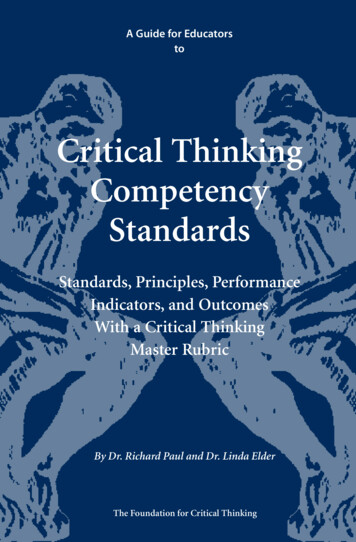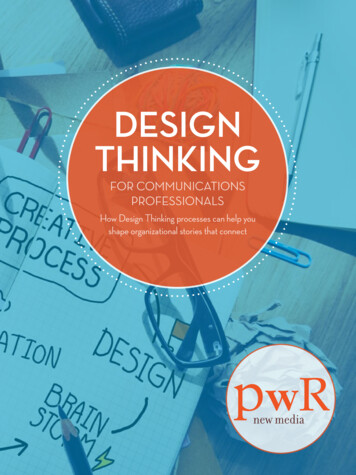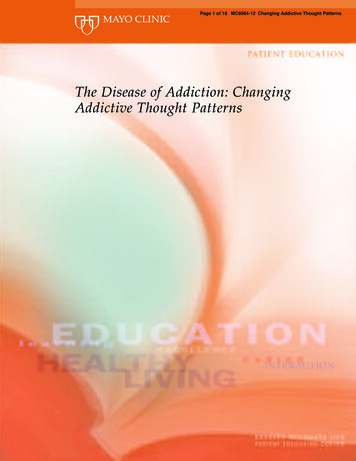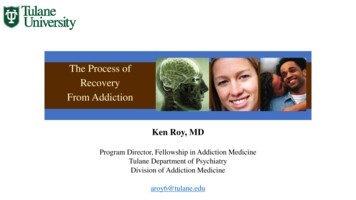
Transcription
International Journal of Management, Accounting and EconomicsVol. 2, No. 8, August, 2015ISSN 2383-2126 (Online) IJMAE, All Rights Reservedwww.ijmae.comKey Elements of Thinking StrategicallyNader Seyed Kalali1Faculty of Management, University of Tehran, IranMansoor MomeniFaculty of Management, University of Tehran, IranElham HeydariFaculty of Management, Allameh Tabataba'i University, IranAbstractStrategic thinking is one of the most important capabilities which managersof today’s organizations must possess. Holding companies, due to the kind ofproblems that they experience, are in serious need of managers capable ofstrategic thinking. The present research has been conducted with the aim ofidentifying the individual dimensions of strategic thinking in holdingcompanies’ managers in Iran. In this regard, a number of managers who havehad the experience of being members of the board of directors or working asCEOs of these firms have been asked to express their opinions about strategicthinking and their views have been analyzed using fuzzy cognitive maps. Resultssuggest that having vision, ability to analyze, having systems thinking, ability toquestion, creativity, ability to make synergy and ability to create advantage arethe main elements of strategic thinking in successful managers of holdingcompanies. In addition, the relationships among these variables have beenexplained.Keywords: Strategic thinking, fuzzy cognitive map and holding companiesCite this article: Seyed Kalali, N., Momeni, M., & Heydari, E. (2015). Key Elements ofThinking Strategically. International Journal of Management, Accounting and Economics, 2(8),801-809.IntroductionWhile the tools and techniques of planning and implementation of strategy have had agrowing trend over the recent decades, research and findings regarding abstract andsubjective concepts such as strategic thinking are still very limited and narrow in scope.1801Corresponding author’s email: nader kalali@ut.ac.ir
International Journal of Management, Accounting and EconomicsVol. 2, No. 8, August, 2015ISSN 2383-2126 (Online) IJMAE, All Rights Reservedwww.ijmae.comThe importance and necessity of strategic thinking is obvious to everyone; today, morethan any other time, we need managers who can think strategically and also promote thisability in all the individuals in the organization. Due to the type of their activity, holdingcompanies’ managers need to pay particular attention to the issue of strategy. Thus, thesemanagers must strengthen their own ability to think strategically.Strategic thinking is not a very clear concept. Although this concept is used frequently,studies in this regard are scarce. In fact, many equate strategic thinking with strategy,strategic management and such concepts and consider research in this regard to beunnecessary. However, it seems that further development of this concept, especially fromthe perspective of behavioral and psychological theories is possible. One of the areaswhich has been studied in the literature of strategic thinking is the elements comprisingstrategic thinking construct at the individual level. In other words, what do we mean whenwe say that a manger thinks strategically? In fact, what is the difference between amanager who thinks strategically and an individual who, let’s say, thinks logically orcritically? The present research seeks to identify the individual elements of strategicthinking in holding companies’ managers in Iran.Research literatureIn the literature of management and social sciences, there are various references todifferent types of thinking including critical, inductive, deductive, systematic andstrategic thinking (Checkland and Haynes, 1994; Glaser, 1941; Dunbar and Fugelsang,2005; Mintzberg, 1994). Identifying and differentiating these types of thinking from eachother is sometimes difficult; yet in some cases, similarities are observed among them.Also in regard to strategic thinking, a variety of opinions have been presented whichoccasionally contradict one another.Mintzberg (1987) argues that strategy can be understood as 5 Ps: plan, ploy, pattern,position and perspective. In the first glance, strategy is considered as a plan; a deliberateand intended approach which has been premeditated. On the other hand, strategy can beconsidered as a pattern in a stream of actions carried out by members of an organization.Therefore strategy as pattern refers to unplanned and emergent strategy (Mintzberg,1987); from this perspective, strategy has not been premeditated and is a fluid andinstantaneous stream. Therefore, the key concepts of deliberate, intended strategy (as planand position) and emergent, unplanned strategy (as a pattern in a stream of decisions) lieat each end of the continuum of strategy formation (Graetz, 2002). In fact, Mintzberg(1994) distinguishes between strategic planning and strategic thinking. He argues thatstrategic planning focuses on analysis and formalization, whereas strategic thinking isbased on synthesis, intuition and creativity. Heracleous (1998) believes that strategicplanning and thinking are two interrelated concepts both of which are essential foreffective strategic management. Obviously, strategic thinking cannot replace strategicplanning. Perhaps it could be argued that for better strategic planning, we must also beequipped with strategic thinking. However, review of the literature of strategic thinkingshows that there is still no consensus regarding the concept of strategic thinking and theterms strategic management, strategic planning and strategic thinking are sometimes usedinterchangeably (Monnavarian et al., 2011).802
International Journal of Management, Accounting and EconomicsVol. 2, No. 8, August, 2015ISSN 2383-2126 (Online) IJMAE, All Rights Reservedwww.ijmae.comIn his research, Bonn (2001) showed that most senior executives in thirty fivecompanies among one hundred major Australian manufacturers mentioned lack ofstrategic thinking as the main problem in their organizations. Bonn (2005) definesstrategic thinking a way of solving strategic problems that combines a rational andconvergent approach with creative and divergent thought processes. He refers to the factthat human beings make sense by building mental representations and states that decisionmakers with high strategic thinking abilities will show a greater diversity inrepresentational systems than decision-makers with low strategic thinking abilities. In apaper published in 2001, Bonn argued that strategic thinking at the individual levelconsists of three elements: a holistic understanding of the organization and itsenvironment (systems thinking), creativity, and a vision for the future of the organization(Bonn, 2001). This is while in 2005, he considers variety in representational systems asthe main requirement for strategic thinking at the individual level and three elements ofsystems thinking, creativity and vision as the main elements of strategic thinking (Bonn,2005). Liedtka (1998) mentions five characteristics of strategic thinking: systemsperspective, intent focused, thinking in time, hypothesis driven and intelligentopportunism. Glamour (2010), in his review of the literature, names twenty characteristicsof strategic thinking as follows: creative, vision of the future, holistic, complex or systemsthinking, rational and analytic, longer time perspective, questioning taken for grantedassumptions, divergent, synthetic, broader context, intuitive, connecting past, present andfuture, problem solving, intent focused, abstract or conceptual, tolerant of risk orambiguity, curious, experimental or exploratory, active in shaping circumstances,focusing on most significant forces, involving values. Casey and Goldman (2010) believethat the development of an individual’s ability to think strategically is a dynamic,interactive, and iterative experiential learning process. Strategy development activitiesconsist of scanning, questioning, conceptualizing, and testing (Casey & Goldman, 2010).Research methodologyThe present research has been conducted with the aim of identifying the individualelements of strategic thinking in holding companies’ managers in Iran. After reviewingthe literature, researchers conducted semi-structured interviews with a number of seniormanagers of holding companies in Iran. Interviewees had a minimum of 10 years ofexperience in top management positions. Interviewees were asked to describe individualcharacteristics of successful managers of holding firms who were well-known forthinking strategically. Then based on the concepts found in the literature of managementand strategic thinking, their descriptions were conceptualized (Table 1). Then aquestionnaire was designed and distributed among the interviewees. Each question wasrelated to one element of strategic thinking and its significance in explaining strategicthinking. Respondents had to assign a degree of importance between 0 and 100 to eachelement of strategic thinking. 10 respondents completed the questionnaire andsubsequently, using FCM technique, the data were analyzed and cognitive map of theresearch variables was obtained. In order to modify and finalize the cognitive map, thefocus group was formed comprising of six experts from the previous phase, the map wasrevised and the final fuzzy cognitive map was obtained.803
International Journal of Management, Accounting and EconomicsVol. 2, No. 8, August, 2015ISSN 2383-2126 (Online) IJMAE, All Rights Reservedwww.ijmae.comTable 1. Individual elements of strategic thinkingNumberElementDefinition1Having visionTo have an idealistic visionof the future in mind2Ability vity6Ability tomake synergy7Ability tocreateadvantageReferencesNapier and Albert (1990),Mintzberg (1994), Liedtka(1998) and Bonn (2001and 2005)Breaking the subjects downPorter (1987), O'Shannassyinto details and studying(2003)them meticulouslyHolistic view of the subjectsNapier and Albert (1990),and seeing the network ofLiedtka (1998) and Bonnrelationships among the(2001 and 2005)componentsQuestioning taken forHeracleous (1998),granted assumptionsLinkow (1999)Combining andmaking connectionsMintzberg (1994), Bonnbetween seemingly(2001 and 2005)unrelated thingsCombining the componentsin such a way that the resultResearch expertsis more than the sum ofcomponentsAchieving better resultsthan othersResearch expertsFuzzy cognitive mapsFuzzy cognitive maps have been used in simulation, modeling organizationalstrategies, strategic problem formulation and analysis of decisions, knowledge basesconstruction, identifying management issues, Failure Mode and Effects Analysis(FMEA), urban design support, relationship management in airline services, etc.(Rodriguez-Repiso et al., 2007). A Fuzzy Cognitive Map (FCM) is a graphicalrepresentation consisting of nodes indicating the most relevant factors of a decisionalenvironment; it also shows the links between these nodes representing the relationshipsbetween those factors (Rodriguez-Repiso, 2005).Fuzzy cognitive maps were first introduced and used by Axelord (1976). In the presentresearch, the methodology developed byRodriguez-Repiso et al. (2007) has been used.This approach uses four matrices to create fuzzy cognitive maps, including Initial Matrixof Success (IMS), Fuzzified Matrix of Success (FZMS), Strength of Relationships Matrixof Success (SRMS) and Final Matrix of Success (FMS). It should be noted that theabovementioned methodology itself has been formulated based on the methodology ofautomatically constructing fuzzy cognitive maps (Schneider et al., 1996). RodriguezRepiso et al. (2006) have used this methodology in order to draw the graphical map ofthe critical success factors. It is noteworthy that once the SRMS matrix is completed,804
International Journal of Management, Accounting and EconomicsVol. 2, No. 8, August, 2015ISSN 2383-2126 (Online) IJMAE, All Rights Reservedwww.ijmae.comsome of the data contained in it could be misleading data. All of the elements are notrelated, and not always there is a relationship of causality between them. An expertopinion is required to analyze the data and convert the SRMS matrix into the FMS matrix(Rodriguez-Repiso et al., 2007). In the present research, focus group method was usedfor finalizing the relationships among the elements.Data analysisForming the initial matrixFirst, based on the scores given by the ten experts to these questions, the Initial Matrixwas formed as shown in Table 2:Table 2: Initial MatrixE1 E2 E3 E4 E5 E6 E7 E8 E9 E10Visi90 75 90 95 90 85 98 80 7580Anal40 20 75 20 30 75 84 50 60 33Syst75 50 90 50 50 75 50 60 50 45Ques 90 20 30 75 45 45 20 45 40 65Creat 70 30 10 80 50 40 20 55 40 84Syn95 80 70 50 40 50 32 60 75 67Adv95 90 80 90 75 60 85 70 75 80It should be noted that the matrix rows in the above table include, respectively, theseven elements of strategic thinking: having vision, ability to analyze, having systemsthinking, questioning, creativity, ability to make synergy and ability to create advantage;and the matrix columns include the answers of each of the ten experts to the questionsregarding the significance of each of these elements.Forming the fuzzified matrixThen, the Fuzzified Matrix was obtained. It should be noted that threshold values of90 and 20 are introduced to correct the possible deviation. Yet, all the answers whichincluded scores equal to or less than 20 were considered as 0 and all the answers whichwere equal to or more than 90 were considered as 1. Table 3 shows the Fuzzified Matrixof the elements of strategic thinking. For instance, X1(O12) is calculated as follows:X1(O12) (75-20)/ (90-20) 0.786805
International Journal of Management, Accounting and EconomicsVol. 2, No. 8, August, 2015ISSN 2383-2126 (Online) IJMAE, All Rights Reservedwww.ijmae.comTable 3. The Fuzzified Matrix of the elements of strategic thinkingE1E2E3E4E5E6E7E8E9E10Visi1.000 0.786 1.000 1.000 1.000 0.929 1.000 0.857 0.786 0.857Anal0.286 0.000 0.786 0.000 0.143 0.786 0.914 0.429 0.571 0.186Syst0.786 0.429 1.000 0.429 0.429 0.786 0.429 0.571 0.429 0.357Ques1.000 0.000 0.143 0.786 0.357 0.357 0.000 0.357 0.286 0.643Creat 0.714 0.143 0.000 0.857 0.429 0.286 0.000 0.500 0.286 0.914Syn1.000 0.857 0.714 0.429 0.286 0.429 0.171 0.571 0.786 0.671Adv1.000 1.000 0.857 1.000 0.786 0.571 0.929 0.714 0.786 0.857Forming the strength of relationships matrixThen, the Strength of Relationships Matrix was obtained as shown in Table 4. In thismatrix, the relationship of each of the seven dimensions with other dimensions has beenshown. For instance, AD12 is calculated as follows:AD (0.714 0.785 0.214 1 0.857 0.142 0.085 0.428 0.214 0.671 )/10 0.511S 1-0.511 0.489Table 4: the Strength of Relationships 710.4800.6560.886Anal Syst0.489 0.6430.7200.7200.549 0.6570.500 0.6510.584 0.7640.517 yn0.6560.5840.7640.7160.6590.8800.716 0.6590.543 0.551 0.741Adv0.8860.5170.6430.5430.5510.741Forming the final matrixIn order to obtain the Final Matrix, the focus group with six members was formed. Themembers of the focus group consisted of six senior managers of Iranian holdingcompanies. Based on their opinions, weak relationships among the research factors wereeliminated and the direction of the relationships was also determined. The Final Matrixhas been shown in Table 5 and the fuzzy cognitive map diagram has been shown in Figure1:806
International Journal of Management, Accounting and EconomicsVol. 2, No. 8, August, 2015ISSN 2383-2126 (Online) IJMAE, All Rights Reservedwww.ijmae.comTable 5: The Final MatrixVisiAnalSystQues Creat SynAdvVisi0.471Anal0.549Syst0.657 0.651 0.764Ques 0.471 0.549 0.6570.880Creat0.651 0.8800.551Syn0.7640.741Adv0.551 0.741Creativity0.651Having Systems Thinking0.8800.6570.549Ability to QuestionEnablersAbility to Analyse0.5510.7640.471Having VisionAbility to CreateAdvantageResults0.741Ability to Make SynergyFigure 1: The elements of strategic thinking and the relationships among them (at theindividual level)Conclusion and recommendationsResults of the present research indicate that the main elements of strategic thinking atthe individual level include having vision, ability to analyze, having systems thinking,ability to question, creativity, ability to make synergy and ability to create advantage.Studying the relationships among these dimensions shows that, respectively, havingvision and ability to analyze affect managers’ questioning ability; having systemsthinking affects questioning ability, creativity and ability to make synergy; the ability toquestion affects creativity; and finally, creativity and ability to make synergy affectabilityto create advantage. It should be noted that, compared to other elements, systems thinkingaffects more elements of strategic thinking and in contrast, the dimension of ability to807
International Journal of Management, Accounting and EconomicsVol. 2, No. 8, August, 2015ISSN 2383-2126 (Online) IJMAE, All Rights Reservedwww.ijmae.comcreate advantage affects none of the elements of strategic thinking and in fact, is the mainoutcome of strategic thinking.As it can be seen in Figure 1, the relationship among five elements of having vision,ability to analyze, having systems thinking, questioning and creativity have been shownwith solid lines and their relationship with the two elements of ability to make synergyand ability to create advantage have been shown with dotted lines. Based on the opinionsof the research experts, the two elements of ability to make synergy and ability to createadvantage are the results of strategic thinking and the five elements of having vision,ability to analyze, having systems thinking, ability to question and creativity are enablersof strategic thinking.A better understanding of strategic thinking will help organizations to recruit and hireindividuals who think more strategically. Furthermore, a better understanding of strategicthinking can improve the quality of decisions made by managers. Research in the field ofstrategic thinking is still new and undeveloped; thus, it is essential that the results ofstudies such as the present study be tested in other industries and geographical areas toallow for creation and development of more complete and accurate models of strategicthinking.ReferencesAxelrod, R. (1976). Structure of decision: The Cognitive Maps of political elites.Princeton, NJ: Princeton University Press.Bonn, I. (2001). Developing strategic thinking as a core competency. ManagementDecision, 39, 63-71.Bonn, I. (2005). Improving strategic thinking: A multilevel approach. Leadership &Organizational Development Journal, 26, 336-354.Casey, A., & Goldman, E. (2010). Enhancing the ability to think strategically: Alearning model. Management Learning, 41, 167-185.Checkland P, Haynes MG. (1994). Varieties of systems thinking: The case of softsystems methodology. System Dynamics Review 10: 189–197.Dunbar, K., &Fugelsang, J. (2005). Scientific thinking and reasoning. In K. J.Holyoak& R. G. Morrison (Eds.), The Cambridge handbook of thinking and reasoning(pp. 705–725). Cambridge, England: Cambridge University Press.Gallimore, K. (2010). Developing a Tentative Framework for Strategic Thinking.British Academy of Management Conference. Sheffield.Glaser, E. M. (1941). An experiment in the development of critical thinking. New York:Columbia University Teachers College.Graetz, F. (2002) Strategic thinking versus strategic planning: towards understandingthe complementarities. Management Decision 40(5/6): 456–63.808
International Journal of Management, Accounting and EconomicsVol. 2, No. 8, August, 2015ISSN 2383-2126 (Online) IJMAE, All Rights Reservedwww.ijmae.comHeracleous, L. (1998). Strategic thinking or strategic planning. Long Range Planning,31(3), 481.Liedtka, J. (1998). Strategic Thinking; Can It Be Taught? Long Range Planning, 31,pp. 120–129.Linkow, P. (1999). What gifted strategic thinkers do? Training & Development 53(7):34-37.Mintzberg, H. (1994). The fall and rise of strategic planning. Harvard BusinessReview, 72(January/February): 107-114.Mintzberg, H., (1987). The strategy concept I: five Ps for strategy, CaliforniaManagement Review, 30, pp. 11-23.Monnavarian, A., Farmani, G., and Yajam, H., (2011). Strategic thinking in Benetton.Business Strategy Series, 12(2), 63-72.Napier N.K., Albert M.S., (1990). East Asian and American perspectives On ThinkingStrategically: The Leopard and His Spots. Asia Pacific Journal of Human Resources. 28:40-50.O'Shannassy, T. (2003). Modern strategic management: Balancing strategic thinkingand strategic planning for internal and external stakeholders." Singapore ManagementReview 25(1): 53-68.Porter, M. E. (1987). The state of strategic thinking. The Economist (23 May): 21-28.Rodriguez-Repiso, L. (2005). Indicators of Success for IT Projects. Case Study. MScSystems Engineering with IT Applications. Cardiff University.Rodriguez-Repiso, L., Setchi, R. &Salmeron, J.L. (2007). Modelling IT Projectssuccess with Fuzzy Cognitive Maps. Expert Systems with Applications 32 (2) 543-559.Schneider M., Shnaider E., Kandel A., and Chew G. (1998). Automatic Constructionof FCMs. Fuzzy Sets and Systems 93, pp. 161-172.809
systems thinking, creativity and vision as the main elements of strategic thinking (Bonn, 2005). Liedtka (1998) mentions five characteristics of strategic thinking: systems perspective, intent focused, thinking










